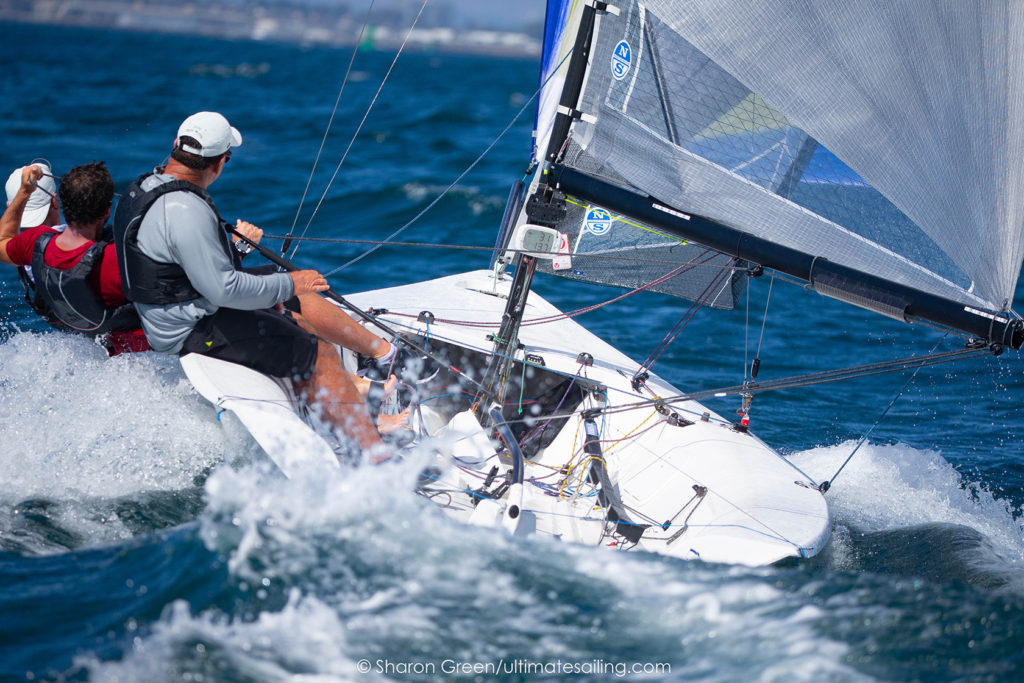By Zeke Horowitz, North One-Design
Achieving top notch downwind performance in the Viper fleet is one of the best ways to make up points on the score board. Sailing in clean air and away from the “blob” (packs of boats) is key to getting maximum VMG.
Generally people think of asymmetric spinnaker boats as having two modes downwind: displacement mode and planing mode. It’s imperative to be able to switch modes when the conditions or circumstances dictate it. One of my favorite things about sailing the Viper is that the “feel” is quite similar in both modes and it always feels FAST. It all comes down to having a balanced helm which we find comes with about five degrees of leeward heel in the boat.

Downwind displacement mode
When you’re in displacement mode (generally under about 12 knots of wind) it’s key to try to get the crew weight to leeward. The driver can be sitting on the floor (as can the trimmer when it’s under about 8 knots) and the forward crew should be either standing on the fore deck or sitting between the leeward shroud and the mast. Encouraging the boat to heel to leeward means that the driver can trim out that leeward heel by turning down—effectively sailing the boat lower (closer to the mark) without losing speed. If the boat is too flat or heeled to windward, the driver will have lee helm which they can only alleviate by sailing higher (further away from the mark).
Downwind planning mode
Generally speaking, in displacement mode you want the bodies and sails to be fairly calm and steady for smooth sailing. This is different from planing mode. Once the breeze is up to that 10-12 knot range, it’s time to start trying to plane.
The feel in the helm should remain about the same; but now you want the driver to sit on the rail so they can see the waves. The forward crew should now have a bigger range of movement and be anywhere from standing on the fore deck (ready to step hard to weather), to sitting on the fore deck between the mast and the weather shroud, to being on the weather rail in front of the shrouds, to behind the weather shroud hiking They need to be ready to move!
The reason is that when the boat is ready to plane, it requires bigger course adjustments from the driver to stay on a plane or steer through/around waves. If the helmsman feels the boat is about to come off the plane (feels the boat getting too flat and starting to get lee helm), the crew should move weight in, the helmsman should pump the main in, and the tiller should get pushed so the bow comes up quickly to try to stay on the plane. When the bow goes up that aggressively, the boat will want to heel to leeward so the crew has to quickly get the weight back out to weather to keep it steady.
Surfing downwind
As the waves become bigger you need to combine the planing mode with the surfing mode. Even more movement and sail adjustment are needed now because, when you find the opportunity to surf a good wave, you’ll want to surf it as low as you can. The trick there is surfing the wave as low as possible without getting so low that you stop planing!
My general rule of thumb in this condition is to search for the surfing waves in a higher faster mode and then once you see the bow way off the water ready to fall down the “cliff,” you turn the boat down and ride down the wave until you feel the boat ever so slightly start to decelerate. As soon as you feel the boat begin slowing down, you want to come back to your high fast mode to look for the next wave. The last thing you want is to surf the wave down for too long because, if you lose the wave, you’re now sailing way too deep and slow and have a big slow turn to make to get back up to a planing angle.
Remember that with big changes in speed come big changes in apparent wind angle and velocity So be ready to make fast adjustments with your tiller, sails, and body weight to be ready for these changes!


